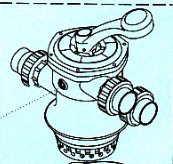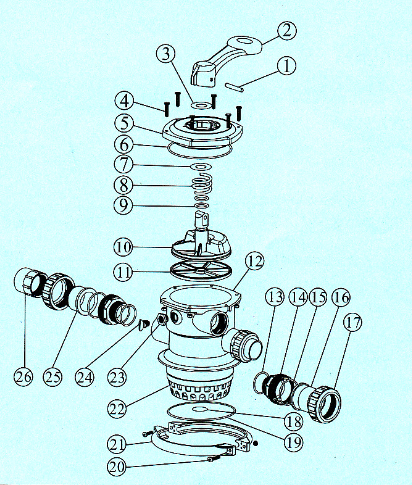Phone : +86 18138709418
Email : sales9@pikespool.comThe swimming pool filter is the most important equipment needed to keep your water looking fresh and clean. You want pool water that clean, which means the filter needs to be kept in optimum working condition. As with the pool pump, pool filter problems need to be fixed quickly.Today we look at some common Sand Pool Filter Problems to watch for, and how to fix your own sand filter trouble, with just basic hand tools, and in some cases a few sand filter parts.

A filter’s Multiport valve is a complex piece of the filter so keeping an eye on it throughout the season is to your advantage. There are over a dozen parts inside a multiport valve, and multiple ports for the water to flow, hence the name. Push-pull valves, mounted on the side of a sand filter, are simpler, with just two ports for filtering or backwashing.
After you finish backwashing it is not unusual to notice a little stream of water continuing to come out the backwash line. Jiggle the handle, and if there’s still water coming out minutes later that signifies a problem with the valve. The majority of the time leaks such as this are from a bad spider gasket on a multiport valve, or plunger o-rings on a push-pull valve. A spider gasket seals up the ports (including the waste water port) to control the direction of your pool water.
Through normal use the gasket rubber will wear down and eventually allow water or debris to bypass the intended direction and escape out the backwash port, or return to the pool unfiltered. Turning the valve while the filter is running can also disrupt the seal. it is worth noting that sometimes the gasket only needs to be cleaned up, reset and lubed.
To inspect or repair a leaking multiport valve, turn off power to your pump and release the pressure in the filter, then remove the screws on top of the valve. Now you can lift out the cover, handle and key stem all in one piece (this is called the key stem assembly). The spider gasket will be sitting within the body of the valve. Clean it off and check for any tears or twisting, or other signs of damage. It can be replaced by lifting out the old gasket with a small, sharp screwdriver, and then gluing in the exact replacement spider gasket (flat side down, ridged side up).
On some valves, the spider gasket is glued into the bottom of the diverter, rather than inside grooves of the valve body. Leaking out the backwash line on this type of valve is more likely to be broken spring on the diverter stem, or debris stuck inside of the valve.
Sand filters can pass some small debris back into the pool, and it can be considered normal, especially if you are vacuuming fine, silty dirt. You may see a stream coming back in through the return lines, during vacuuming, or right after backwashing. Vacuuming to waste will fix the former, and using the Rinse setting after backwashing will fix the latter.

Using too much force, or large tree branches can break the handle on top of a multiport valve. If the handle has a lot of movement in it, or is real floppy, you may have to replace the spring within the key stem assembly. In this case, it may be better to replace the key assembly; it's definitely a lot easier.
To replace just the handle, remove the key stem assembly as described above, and place it on a soft surface where you can apply pressure to the top cover (compressing the spring) and remove the pin that runs through the handle by tapping it out. Once the handle is off, check the large nylon washers that lie underneath it within the middle of the top cover; it can crack over time and this too can disrupt proper handle function. There are also o-rings on the stem that goes through the lid. Clean and/or replace any valve parts that need replacement, then put back it all back together, being careful to replace the lid in the exact same orientation over the diverter, so that everything lines up correctly.
This one’s even easier…it is not safe to repair a cracked tank; you need to purchase a new one, and it's usually cheaper to buy an entire new filter than to just buy the tank. Patching a pressure tank like a sand filter will always fail, and the eventual rupture could drain the pool, or injure someone standing nearby. There are other sand filter leaks that can be fixed however.
Broken Laterals? If your sand filter is leaking sand, into the pool, constantly (not just after backwashing), this is usually a broken lateral. Laterals are plastic parts at the bottom of the sand filter, with slits so small that it keeps out sand grains, until it cracks that is. It could also be a broken standpipe or diffuser – all internal parts that crack can leak sand into the pool.
You may see a short cloud of dusty sand right after backwashing, but when a lateral bursts, you will know it – several handfuls of sand or even much more will be on the floor, below the returns.
The solution? Drain the tank, scoop out the sand, and replace the entire set of laterals. You can reuse the filter sand if it's still in good shape. Generally, pool filter sand lasts about 5-7 years before it wears out and needs to be replaced.
A sand filter needs backwashing when the pressure gauge reads 8-10 lbs higher than the pressure after cleaning. When you backwash, water goes through the filter tank backwards, hence the name. Backwashing for 3-5 minutes flushes out the dirt from the sand bed and out the waste line or hose.
"Normal" sand filter pressure? Something around 10 psi is usual, but it depends on the pump size, pipe size and resistance from the other equipment that you have. So, a normal filter pressure could be anything from 5-25 psi.
But what is happening if you backwash the filter and the pressure remains high? Here's some things to check.
~ Sand pool filter repairs are urgent, you've got to get the water filtering again fast. If you can't filter the water while awaiting sand filter parts, you may be able to at least circulatethe water, by using the filter bypass setting, Recirculate. Keep the chlorine level high by adding granular pool shock, and brush and skim the pool daily until you can make the filter repair.
Give us a call if you want to discuss your sand filter problems - ask for me. my mobile:+8613928998562